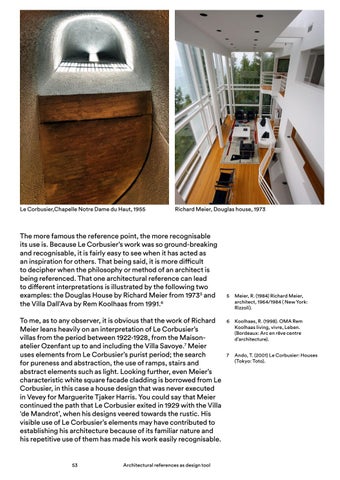Le Corbusier,Chapelle Notre Dame du Haut, 1955
Richard Meier, Douglas house, 1973
The more famous the reference point, the more recognisable its use is. Because Le Corbusier’s work was so ground-breaking and recognisable, it is fairly easy to see when it has acted as an inspiration for others. That being said, it is more difficult to decipher when the philosophy or method of an architect is being referenced. That one architectural reference can lead to different interpretations is illustrated by the following two examples: the Douglas House by Richard Meier from 1973 5 and the Villa Dall’Ava by Rem Koolhaas from 1991.6 To me, as to any observer, it is obvious that the work of Richard Meier leans heavily on an interpretation of Le Corbusier’s villas from the period between 1922-1928, from the Maisonatelier Ozenfant up to and including the Villa Savoye.7 Meier uses elements from Le Corbusier’s purist period; the search for pureness and abstraction, the use of ramps, stairs and abstract elements such as light. Looking further, even Meier’s characteristic white square facade cladding is borrowed from Le Corbusier, in this case a house design that was never executed in Vevey for Marguerite Tjaker Harris. You could say that Meier continued the path that Le Corbusier exited in 1929 with the Villa ‘de Mandrot’, when his designs veered towards the rustic. His visible use of Le Corbusier’s elements may have contributed to establishing his architecture because of its familiar nature and his repetitive use of them has made his work easily recognisable.
53
Architectural references as design tool
5 Meier, R. (1984) Richard Meier, architect, 1964/1984 ( New York: Rizzoli). 6 Koolhaas, R. (1998). OMA Rem Koolhaas living, vivre, Leben. (Bordeaux: Arc en rêve centre d’architecture). 7 Ando, T. (2001) Le Corbusier: Houses (Tokyo: Toto).
